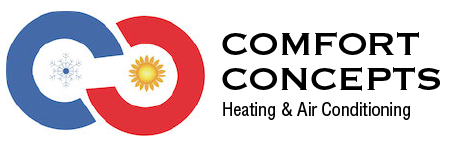
Ceiling fans are one of the most underappreciated ways to increase home comfort and cut energy costs. By boosting air circulation and working in conjunction with your HVAC system, ceiling fans and energy efficiency are truly a natural pairing. They offer a cost-effective, eco-friendly way to stay cool while easing strain on your AC—helping you avoid unnecessary air conditioning repair.
In this blog, the experts at Comfort Concepts Heating & Air Conditioning discuss how ceiling fans can improve your comfort while avoiding energy waste with increased HVAC efficiency. We'll also offer some HVAC efficiency tips that put to good use ceiling fans.
Comfort vs. Temperature: The Effect of the Wind-Chill Effect Indoors
Ceiling fans don’t actually cool the air—they make your home more comfortable by blowing air across your skin. This is called the wind-chill effect, and it can make a room feel up to 4 degrees cooler without adjusting the thermostat. That means you stay comfortable and enjoy the benefits of indoor air circulation from your ceiling fan while using less AC—helping reduce your electric bill in summer.
The Best of Both: Benefits of Using Fans and Air Conditioning Together
There are several upsides to using ceiling fans and air conditioning together, especially on hotter days. By pairing both, you boost HVAC efficiency and enjoy a cooler living space with less work from your cooling system.
Top perks of using ceiling fans and AC together:
- Ceiling fans help lower HVAC load by spreading cool air more evenly around rooms in your home. Decreasing HVAC stress is important, because it can save you from a breakdown that may result in premature AC or furnace installation.
- Using overhead fans improves your indoor comfort by getting rid of warm pockets and enhancing circulation.
- Running both ceiling fans and AC can reduce overall energy use. If you have a home automation system, you can even modify your smart thermostat settings to bump up the temp a few degrees while your ceiling fan is running.
Clockwise vs. Counterclockwise Ceiling Fan Rotation: Which Direction Should a Fan Spin?
To make full use of your ceiling fans year-round, it’s important to set the blades to rotate in the proper direction for the season. The direction affects how air moves, which can either or gently recirculate warm air so you feel warmer.
When to spin ceiling fans counterclockwise
In the summer, ceiling fans should rotate counterclockwise at a quick speed. This creates a breeze that moves air toward the floor, amplifying the wind-chill effect and creating a cooler sensation.
When to spin ceiling fans clockwise
On cold days, set your fan to spin clockwise on a low speed. This lifts cooler air and draws warm air downward from the ceiling, so you feel warmer without changing your thermostat.
What Type of Ceiling Fan Is Best
Picking the right ceiling fan depends on a few critical considerations, including blade design, airflow rating and room dimensions. First, look for fans that offer a good combination of ECFM airflow and blade pitch to provide efficient air circulation in your home:
- ECFM refers to the amount of air a fan circulates—the cubic feet per minute, or CFM—per watt of electricity consumed. Fans with greater ECFM are more energy efficient.
- Blade pitch refers to the tilt of the blades. A steeper blade pitch moves more air than a shallower pitch but can also strain the motor.
Also, consider room size when sizing a ceiling fan—a fan that’s too small won’t move enough air, while one that’s too large may be too strong for the space.
Boost Your HVAC Efficiency With the Team from Comfort Concepts Heating & Air Conditioning
At Comfort Concepts Heating & Air Conditioning, our HVAC specialists can help you enjoy year-round comfort while minimizing wear on your heating and cooling systems. From practical fan advice and air conditioning installation to smart thermostats and furnace repair, we offer comprehensive services that work with your budget. Schedule your appointment by calling 405-494-7444 today.

